Weighing scale
Weighing scales (or weigh scales or scales) are devices to measure weight or calculate mass. Spring balances or spring scales measure weight (force) by balancing the force due to gravity against the force on a spring, whereas a balance or pair of scales using a balance beam compares masses by balancing the weight due to the mass of an object against the weight of a known mass or masses. Either type can be calibrated to read in units of force such as newtons, or in units of mass such as kilograms, but the balance or pair of scales using a traditional balance beam to compare masses will read correctly for mass even if moved to a place with a different (non-zero) gravitational field strength (but would then not read correctly if calibrated in units of force), while the spring balance would read correctly in force in a different gravitational field strength (but would not read correctly if calibrated in units of mass).
Scales and balances are widely used in commerce, as many products are sold and packaged by weight. Very accurate balances, called analytical balances, are used in scientific fields such as chemistry.
Force-measuring (weight) scales
History

Although records dating to the 1700s refer to spring scales for measuring weight, the earliest design for such a device dates to 1770 and credits Richard Salter, an early scale-maker.[1] Spring scales came into wide usage in the United Kingdom after 1840 when R. W. Winfield developed the candlestick scale for weighing letters and packages, required after the introduction of the Uniform Penny Post.[2] Postal workers could work more quickly with spring scales than balance scales because they could be read instantaneously and did not have to be carefully balanced with each measurement.
By the 1940s various electronic devices were being attached to these designs to make readings more accurate.[1][3] Load cells, small nodes that convert pressure (or force) to a digital signal, have their beginnings as early as the late nineteenth century, but it was not until the late twentieth century that they became accurate enough for widespread usage.[4]
Mechanical scales
Spring scales
A spring scale measures weight by reporting the distance that a spring deflects under a load. This contrasts to a balance, which compares the torque on the arm due to a sample weight to the torque on the arm due to a standard reference weight using a horizontal lever. Spring scales measure force, which is the tension force of constraint acting on an object, opposing the local force of gravity. They are usually calibrated so that measured force translates to mass at earth's gravity. The object to be weighed can be simply hung from the spring or set on a pivot and bearing platform.
In a spring scale, the spring either stretches (as in a hanging scale in the produce department of a grocery store) or compresses (as in a simple bathroom scale). By Hooke's law, every spring has a proportionality constant that relates how hard it is pulled to how far it stretches. Weighing scales use a spring with a known spring constant (see Hooke's law) and measure the displacement of the spring by any variety of mechanisms to produce an estimate of the gravitational force applied by the object. Rack and pinion mechanisms are often used to convert the linear spring motion to a dial reading.
Spring scales have two sources of error that balances do not: the measured weight varies with the strength of the local gravitational force (by as much as 0.5% at different locations on Earth), and the elasticity of the measurement spring can vary slightly with temperature. With proper manufacturing and setup, however, spring scales can be rated as legal for commerce. To remove the temperature error, a commerce-legal spring scale must either have temperature-compensated springs or be used at a fairly constant temperature. To eliminate the effect of gravity variations, a commerce-legal spring scale must be calibrated where it is used.
Hydraulic or pneumatic scale
It is also common in high-capacity applications such as crane scales to use hydraulic force to sense weight. The test force is applied to a piston or diaphragm and transmitted through hydraulic lines to a dial indicator based on a Bourdon tube or electronic sensor.[5]
Digital scales
Digital bathroom scale
A digital bathroom scale is a type of electronic weighing machine, which is used to measure many readings including body fat, BMI, lean mass, muscle mass, water ratio along with body weight. The digital bathroom scale is a smart scale which has many functions like smartphone integration, cloud storage, fitness tracking, etc.[6]
Strain gauge scale
In electronic versions of spring scales, the deflection of a beam supporting the unknown weight is measured using a strain gauge, which is a length-sensitive electrical resistance. The capacity of such devices is only limited by the resistance of the beam to deflection. The results from several supporting locations may be added electronically, so this technique is suitable for determining the weight of very heavy objects, such as trucks and rail cars, and is used in a modern weighbridge.
Supermarket and other retail scale
These scales are used in the modern bakery, grocery, delicatessen, seafood, meat, produce and other perishable goods departments. Supermarket scales can print labels and receipts, mark weight/count, unit price, total price and in some cases tare.[7] Some modern supermarket scales print an RFID tag that can be used to track the item for tampering or returns. In most cases these types of scales have a sealed calibration so that the reading on the display is correct and cannot be tampered with. In the USA the scales are certified by the National Conference on Weights and Measures' NTEP, in South Africa by the South African Bureau of Standards and in the UK by the International Organization of Legal Metrolog.
Testing and certification
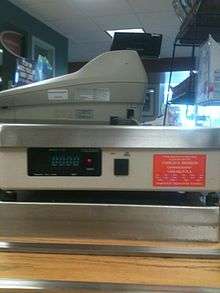
Most countries regulate the design and servicing of scales used for commerce. This has tended to cause scale technology to lag behind other technologies because expensive regulatory hurdles are involved in introducing new designs. Nevertheless, there has been a recent trend to "digital load cells" which are actually strain-gauge cells with dedicated analog converters and networking built into the cell itself. Such designs have reduced the service problems inherent with combining and transmitting a number of 20 millivolt signals in hostile environments.
Government regulation generally requires periodic inspections by licensed technicians using weights whose calibration is traceable to an approved laboratory. Scales intended for non-trade use such as those used in bathrooms, doctor's offices, kitchens (portion control), and price estimation (but not official price determination) may be produced, but must by law be labelled "Not Legal for Trade" to ensure that they are not re-purposed in a way that jeopardizes commercial interest. In the United States, the document describing how scales must be designed, installed, and used for commercial purposes is NIST Handbook 44. Legal For Trade (LFT) certification usually approve the readability as repeatability/10 to ensure a maximum margin of error of 10%.
Because gravity varies by over 0.5% over the surface of the earth, the distinction between force due to gravity and mass is relevant for accurate calibration of scales for commercial purposes. Usually the goal is to measure the mass of the sample rather than its force due to gravity at that particular location.
Traditional mechanical balance-beam scales intrinsically measured mass. But ordinary electronic scales intrinsically measure the gravitational force between the sample and the earth, i.e. the weight of the sample, which varies with location. So such a scale has to be re-calibrated after installation, for that specific location, in order to obtain an accurate indication of mass.
Sources of error
Some of the sources of error in weighing are:
- Buoyancy – Objects in air develop a buoyancy force that is directly proportional to the volume of air displaced. The difference in density of air due to barometric pressure and temperature creates errors.[8]
- Error in mass of reference weight
- Air gusts, even small ones, which push the scale up or down
- Friction in the moving components that causes the scale to reach equilibrium at a different configuration than a frictionless equilibrium should occur.
- Settling airborne dust contributing to the weight
- Mis-calibration over time, due to drift in the circuit's accuracy, or temperature change
- Mis-aligned mechanical components due to thermal expansion or contraction of components
- Magnetic fields acting on ferrous components
- Forces from electrostatic fields, for example, from feet shuffled on carpets on a dry day
- Chemical reactivity between air and the substance being weighed (or the balance itself, in the form of corrosion)
- Condensation of atmospheric water on cold items
- Evaporation of water from wet items
- Convection of air from hot or cold items
- Gravitational differences for a scale which measures force, but not for a balance.[9]
- Vibration and seismic disturbances
Balance scales
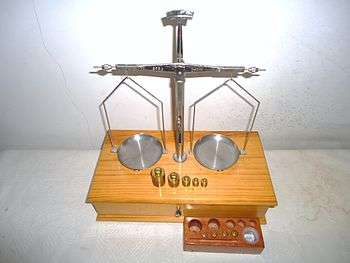
The original form of a balance consisted of a beam with a fulcrum at its center. For highest accuracy, the fulcrum would consist of a sharp V-shaped pivot seated in a shallower V-shaped bearing. To determine the mass of the object, a combination of reference masses was hung on one end of the beam while the object of unknown mass was hung on the other end (see balance and steelyard balance). For high precision work, such as empirical chemistry, the center beam balance is still one of the most accurate technologies available, and is commonly used for calibrating test weights.
Mechanical balances
The balance (also balance scale, beam balance and laboratory balance) was the first mass measuring instrument invented.[10] In its traditional form, it consists of a pivoted horizontal lever with arms of equal length – the beam – and a weighing pan[11] suspended from each arm (hence the plural name "scales" for a weighing instrument). The unknown mass is placed in one pan and standard masses of known weight are added to the other pan until the beam is as close to equilibrium as possible. In precision balances, a more accurate determination of the mass is given by the position of a sliding mass moved along a graduated scale. Technically, a balance compares weight rather than mass, but, in a given gravitational field (such as Earth's gravity), the weight of an object is proportional to its mass, so the standard "weights" used with balances are usually labeled in units of mass (g, kg, etc.).



Unlike spring-based scales, balances are used for the precision measurement of mass as their accuracy is not affected by variations in the local gravitational field. (On Earth, for example, these can amount to ±0.5% between locations.[12]) A change in the strength of the gravitational field caused by moving the balance will not change the measured mass, because the moments of force on either side of the beam are affected equally. A balance will render an accurate measurement of mass at any location experiencing a constant gravity or acceleration.
Very precise measurements are achieved by ensuring that the balance's fulcrum is essentially friction-free (a knife edge is the traditional solution), by attaching a pointer to the beam which amplifies any deviation from a balance position; and finally by using the lever principle, which allows fractional masses to be applied by movement of a small mass along the measuring arm of the beam, as described above. For greatest accuracy, there needs to be an allowance for the buoyancy in air, whose effect depends on the densities of the masses involved.

To reduce the need for large reference masses, an off-center beam can be used. A balance with an off-center beam can be almost as accurate as a scale with a center beam, but the off-center beam requires special reference masses and cannot be intrinsically checked for accuracy by simply swapping the contents of the pans as a center-beam balance can. To reduce the need for small graduated reference masses, a sliding weight called a poise can be installed so that it can be positioned along a calibrated scale. A poise adds further intricacies to the calibration procedure, since the exact mass of the poise must be adjusted to the exact lever ratio of the beam.
For greater convenience in placing large and awkward loads, a platform can be floated on a cantilever beam system which brings the proportional force to a noseiron bearing; this pulls on a stilyard rod to transmit the reduced force to a conveniently sized beam.
One still sees this design in portable beam balances of 500 kg capacity which are commonly used in harsh environments without electricity, as well as in the lighter duty mechanical bathroom scale (which actually uses a spring scale, internally). The additional pivots and bearings all reduce the accuracy and complicate calibration; the float system must be corrected for corner errors before the span is corrected by adjusting the balance beam and poise.
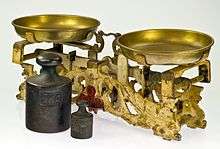
Roberval balance
In 1669 the Frenchman Gilles Personne de Roberval presented a new kind of balance scale to the French Academy of Sciences. This scale consisted of a pair of vertical columns separated by a pair of equal-length arms and pivoting in the center of each arm from a central vertical column, creating a parallelogram. From the side of each vertical column a peg extended. To the amazement of observers, no matter where Roberval hung two equal weight along the peg, the scale still balanced. In this sense, the scale was revolutionary: it evolved into the more-commonly encountered form consisting of two pans placed on vertical column located above the fulcrum and the parallelogram below them. The advantage of the Roberval design is that no matter where equal weights are placed in the pans, the scale will still balance.
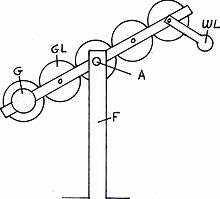
Further developments have included a "gear balance" in which the parallelogram is replaced by any odd number of interlocking gears greater than one, with alternating gears of the same size and with the central gear fixed to a stand and the outside gears fixed to pans, as well as the "sprocket gear balance" consisting of a bicycle-type chain looped around an odd number of sprockets with the central one fixed and the outermost two free to pivot and attached to a pan.
Because it has more moving joints which add friction, the Roberval balance is consistently less accurate than the traditional beam balance, but for many purposes this is compensated for by its usability.
Electronic devices
Microbalance
A microbalance is an instrument capable of making precise measurements of weight of objects of relatively small mass: of the order of a million parts of a gram.
Analytical balance
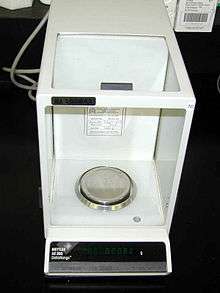
An analytical balance is a class of balance designed to measure small mass in the sub-milligram range. The measuring pan of an analytical balance (0.1 mg or better) is inside a transparent enclosure with doors so that dust does not collect and so any air currents in the room do not affect the balance's operation. This enclosure is often called a draft shield. The use of a mechanically vented balance safety enclosure, which has uniquely designed acrylic airfoils, allows a smooth turbulence-free airflow that prevents balance fluctuation and the measure of mass down to 1 μg without fluctuations or loss of product. Also, the sample must be at room temperature to prevent natural convection from forming air currents inside the enclosure from causing an error in reading. Single-pan mechanical substitution balance maintains consistent response throughout the useful capacity is achieved by maintaining a constant load on the balance beam, thus the fulcrum, by subtracting mass on the same side of the beam to which the sample is added.
Electronic analytical scales measure the force needed to counter the mass being measured rather than using actual masses. As such they must have calibration adjustments made to compensate for gravitational differences.[13] They use an electromagnet to generate a force to counter the sample being measured and outputs the result by measuring the force needed to achieve balance. Such measurement device is called electromagnetic force restoration sensor.[14]
Pendulum balance scales
Pendulum type scales do not use springs. This design uses pendulums and operates as a balance and is unaffected by differences in gravity. An example of application of this design are scales made by the Toledo Scale Company.[15]
Symbolism

The scales (specifically, a two-pan, beam balance) are one of the traditional symbols of justice, as wielded by statues of Lady Justice. This corresponds to the use in metaphor of matters being "held in the balance". It has its origins in ancient Egypt.
Scales are also the symbol for the astrological sign Libra.
History of the balance scale
The balance scale is such a simple device that its usage likely far predates the evidence. What has allowed archaeologists to link artifacts to weighing scales are the stones for determining absolute weight. The balance scale itself was probably used to determine relative weight long before absolute weight.[10]
The oldest evidence for the existence of weighing scales dates to c. 2400–1800 B.C. in the Indus River valley (modern-day Pakistan). Prior to that, no banking was performed due to lack of scales. Uniform, polished stone cubes discovered in early settlements were probably used as weight-setting stones in balance scales. Although the cubes bear no markings, their weights are multiples of a common denominator. The cubes are made of many different kinds of stones with varying densities. Clearly their weight, not their size or other characteristics, was a factor in sculpting these cubes.[1] In Egypt, scales can be traced to around 1878 B.C., but their usage probably extends much earlier. Carved stones bearing marks denoting weight and the Egyptian hieroglyphic symbol for gold have been discovered, which suggests that Egyptian merchants had been using an established system of weight measurement to catalog gold shipments and/or gold mine yields. Although no actual scales from this era have survived, many sets of weighing stones as well as murals depicting the use of balance scales suggest widespread usage.[1]
Variations on the balance scale, including devices like the cheap and inaccurate bismar (unequal-armed scales),[16] began to see common usage by c. 400 B.C. by many small merchants and their customers. A plethora of scale varieties each boasting advantages and improvements over one another appear throughout recorded history, with such great inventors as Leonardo da Vinci lending a personal hand in their development.[3]
Even with all the advances in weighing scale design and development, all scales until the seventeenth century AD were variations on the balance scale.
 Weighing dishes from the island of Thera, Minoan civilization, 2000–1500 BC
Weighing dishes from the island of Thera, Minoan civilization, 2000–1500 BC- Assyrian lion weights (8th century BC) in the British Museum
 Emperor Jahangir (reigned 1605–1627) weighing his son Shah Jahan on a weighing scale by artist Manohar (AD 1615, Mughal dynasty, India).
Emperor Jahangir (reigned 1605–1627) weighing his son Shah Jahan on a weighing scale by artist Manohar (AD 1615, Mughal dynasty, India).
Hybrid spring and balance scales
Elastic arm scale

In 2014 a concept of hybrid scale has been introduced, the elastically deformable arm scale,[17] which is a combination between a spring scale and a beam balance, exploiting simultaneously both principles of equilibrium and deformation. In this scale, the rigid arms of a classical beam balance (for example a steelyard) are replaced with a flexible elastic rod in an inclined frictionless sliding sleeve. The rod can reach a unique free of sliding equilibrium when two vertical dead loads (or masses) are applied at its edges. Equilibrium, which would be impossible with rigid arms, is guaranteed because configurational forces develop at the two edges of the sleeve as a consequence of both the free sliding condition and the nonlinear kinematics of the elastic rod. This weight measuring device can also work without a counterweight.
See also
- Auncel
- Ampere balance
- Evans balance
- Faraday balance
- Gouy balance
- Roberval balance
- Steelyard balance
- Watt balance
- Apparent weight
- AutoAnalyzer
- Combination weigher
- Mass versus weight
- Multihead weigher
- Nutrition scale
- Digital spoon scale
- Tare weight
- Truck scale
- Weigh house - historic public building for the weighing of goods
- Weigh lock - for weighing canal barges
References
- 1 2 3 4 Petruso, Karl M (1981). ""Early Weights and Weighing in Egypt and the Indus Valley", M Bulletin". Boston Museum of Fine Arts. pp. 44–51. JSTOR 4171634. (Subscription required (help)).
- ↑ Brass, Brian (2006). ""Candlesticks, Part 1", Equilibrium, No. 1" (PDF). Isasc.org. pp. 3099–3109. Retrieved 2014-02-26.
- 1 2 "The History of Weighing". Averyweigh-tronix.com. 2012-03-02. Archived from the original on March 2, 2012. Retrieved 2014-03-05.
- ↑ "Load Cells". Omega.com. Retrieved 2014-02-26.
- ↑ "A brief history of weights and measures" (PDF). California Department of Food and Agriculture Division of Measurement Standards.
- ↑ "Best Bathroom Scale".
- ↑ "Aflak Electronics Weighing Scale". Retrieved 11 November 2014.
- ↑ "Applying air buoyancy corrections" (PDF). Andrew.ucsd.edu. September 29, 1997. Archived from the original (PDF) on September 7, 2006. Retrieved 2014-03-05.
- ↑ "Practical Uncertainty Limits to the Mass Determination of a Piston-Gage Weight" (PDF). Nist.gov. Retrieved 2014-02-26.
- 1 2 "Download – A Short History to Weighing: AWTX Museum Book". Averyweigh-tronix.com. Archived from the original on March 2, 2012. Retrieved 2015-03-05.
- ↑ Or "scale", "scalepan" or the obsolete "basin" (A Practical Dictionary of the English and German Languages (1869), p. 1069).
- ↑ Hodgeman, Charles, Ed. (1961). Handbook of Chemistry and Physics, 44th Ed. Cleveland, USA: Chemical Rubber Publishing Co. pp. 3480–3485.
- ↑ "A&D training material" (PDF). Sandd.jp. Retrieved 2014-02-26.
- ↑ "Sensors Mag". Archives.sensorsmag.com. Retrieved 2014-02-26.
- ↑ "Finding Aid : The Toledo Scale Collection" (PDF). Utoledo.edu. Retrieved 2014-02-26.
- ↑ "ISASC". ISASC. Retrieved 2014-02-26.
- ↑ F. Bosi, D. Misseroni, F. Dal Corso and D. Bigoni, An Elastica Arm Scale. Proceedings of the Royal Society A, 470, 20140232.
External links
| Wikimedia Commons has media related to Weighing scales. |
| Wikisource has the text of the 1911 Encyclopædia Britannica article Balance. |
- National Conference on Weights and Measures, NIST Handbook 44, Specifications, Tolerances, And Other Technical Requirements for Weighing and Measuring Devices, 2003
- Analytical Balance article at ChemLab
- "The Precious Necklace Regarding Weigh Scales" is an 18th-century manuscript by Abd al-Rahman al-Jabarti about the "design and operation" of scales
- The history of weighing scale, The balance, Romans, Da vinci y roberval